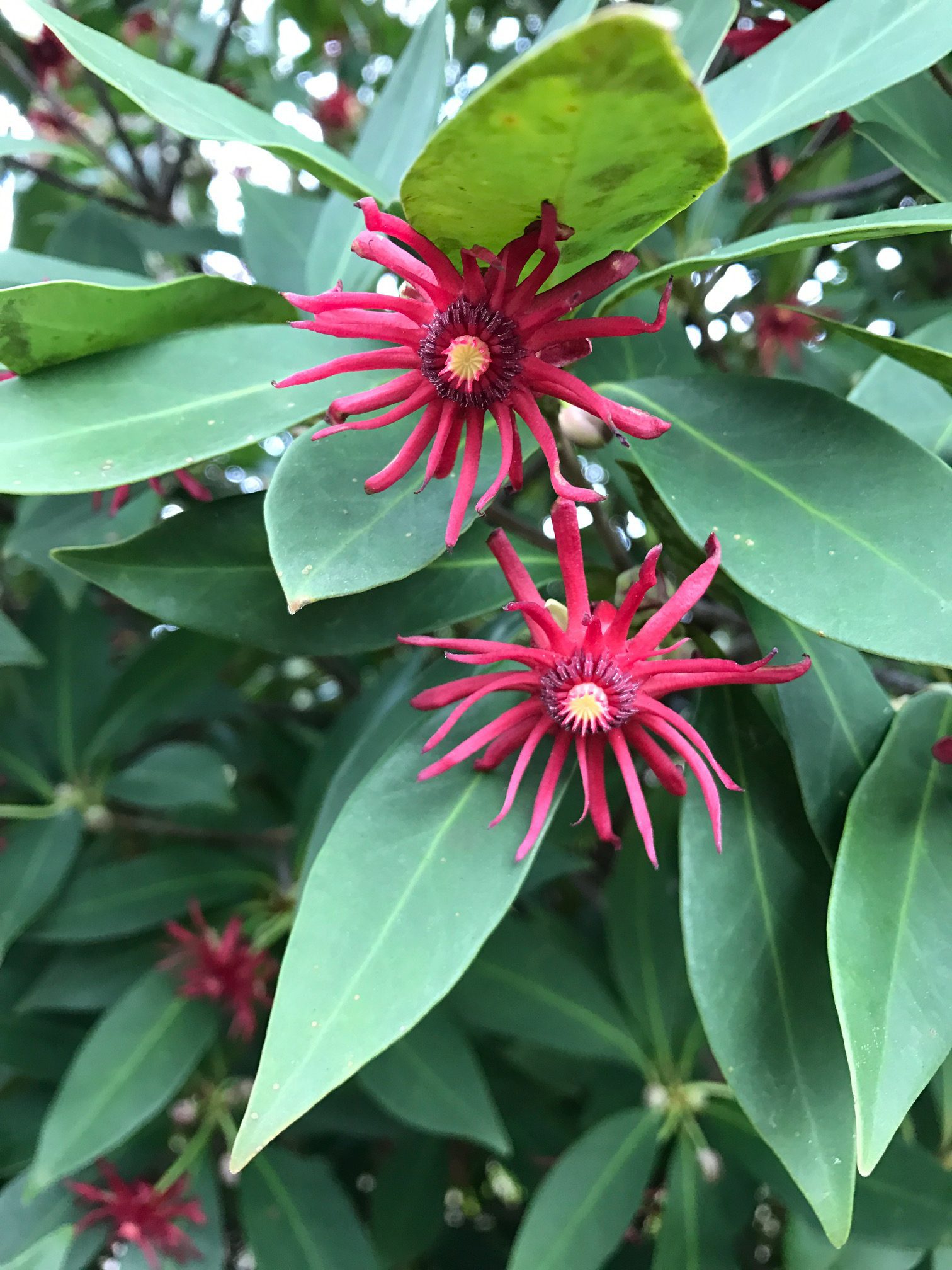
by Mary Salinas | Mar 9, 2017
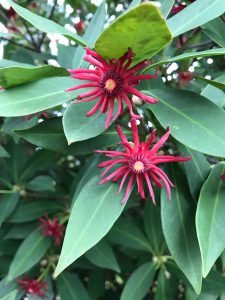
Dark red flowers of Florida red anise arrive in the springtime. Photo credit: Mary Derrick, UF/IFAS Extension.
Springtime brings small but very pretty red blooms on an outstanding native shrub/small tree, Florida red anise (Illicium floridanum). It occurs naturally in the wild in the central and western panhandle of Florida and west along the gulf coast into Louisiana. Its natural environment is in the understory along streams and in rich, wooded areas.
This is a great shrub for a part shade to shady and moist area in your landscape. The dense foliage, dark green leaves and the fact that it is evergreen all year makes it a great choice for an informal hedge. Plan for it to grow to a maximum height of 12 to 15 feet.
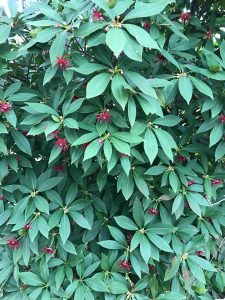
Dense growth habit of Florida red anise. Photo credit: Mary Derrick, UF/IFAS Extension.
The leaves have a licorice-like aroma when crushed but this is NOT the species that gives us the edible culinary anise. Maybe it is that aroma that makes this a relatively pest-free plant!
Yellow anise (Illicium parviflorum) is a very similar native shrub but has small yellow flowers and adapts better to a drier environment. The native range of the yellow anise is north central Florida.
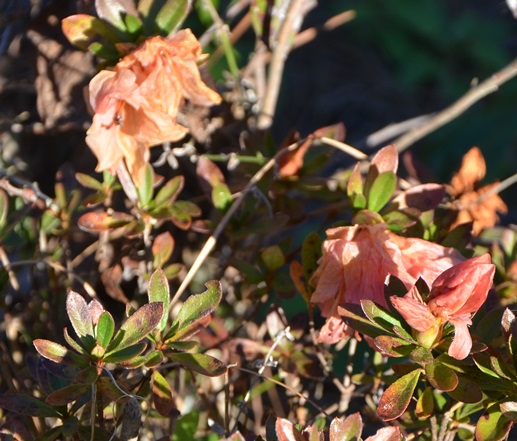
by Les Harrison | Feb 3, 2017
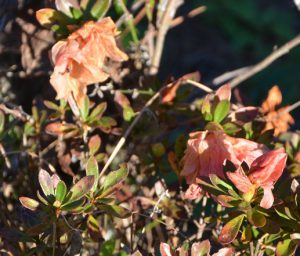
Photo caption: Local azaleas were prematurely blooming
This winter’s exceptional weather has deceived some popular springtime ornamental shrubs and fruit trees into flowering prematurely. Azaleas, for example, began blooming because of winter temperatures mush warmer than average.
There are number of variables which determine when a plant will bloom each year, including the sun, water, and air temperature. To understand why the plants bloom, there should be an understanding of “photoperiodism”, meaning the effects of light and darkness on some plant species.
Certain plants respond to the day length. Some are long day plants which flower in spring and summer, and some are short day plants flowering in fall and winter. Then there are plants which will bloom in any season, identified as day neutral plants.
Long and short day plants will not be directly affected by prevailing weather conditions. For example chrysanthemums, which are short day plant naturally bloom in winter.
These plants can be forced to bloom in summer by keeping them in a dark room for 12 hours a day for several weeks. Many nurseries supplying florist uses this technique and utilize greenhouses with blackout systems. They also use grow lights to produce early season blooms on spring/summer flowers sold for Valentine Day.
For those neutral day plants there is “vernalization”. These plants must be exposed to cold weather to some greater or lesser amount.
Most temperate fruit trees need exposure to cold temperatures. When winters are too mild or contain intermittent warmer periods, dormancy is prematurely terminated and bud break starts.
Most of the exposed buds of these fruit trees can survive freezing temperatures, but many of their flowers will be killed if exposed to a late arriving hard freeze or frost.
After the freeze most of the flowers may appear normal, but the center part of the flower where the reproductive organs reside are killed and result in no fruit formation. Covering plants in-bloom provides some freeze protection.
With a warm early winter, like December 2016, there has been irregular and premature flowering.
Another consideration is fruit trees or shrubs pruned too early winter. Warm weather combined with the pruning stimulates the growth of new shoots.
There is a hormone produced in lateral or terminal shoot buds which travels down the shoots inhibiting their growth. When the terminal shoots are pruned too early the growth inhibiting hormone is removed.
The warm days during winter may cause these newly pruned plants to form new shoots. The new growth is tender and very susceptible to freeze injuries. Pruning in late January or February will likely deliver the best results.
For shrubs like azaleas and gardenias, flower buds are set in summer, long before they can be identified by most people. Losing the buds, no matter the cause, after midsummer drastically decreases the number of flowers the following spring.
To learn more about the spring bloom for 2017, visit the UF/IFAS County Extension website
By: Gohar Umar, FAMU Extension Horticulture Specialist, and Les Harrison, Wakulla County Extension Director
Photo caption: Local azaleas were prematurely blooming
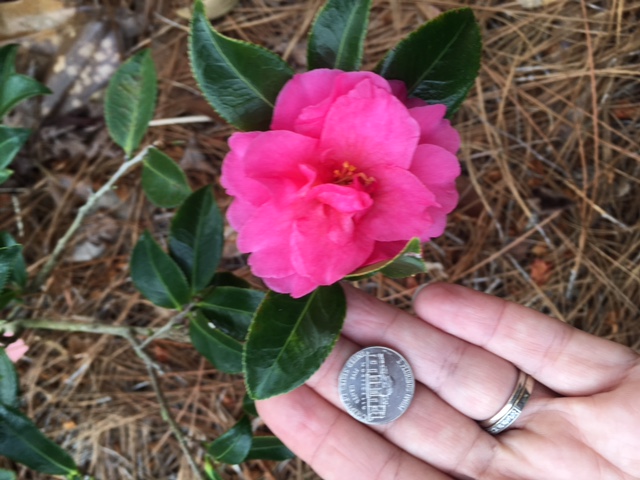
by Julie McConnell | Jan 17, 2017
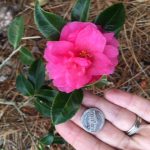
Winter flowers and small leaves with serrated edges lead to identification as Camellia sasanqua. Photo: J_McConnell, UF/IFAS
A common diagnostic service offered at your local UF/IFAS Extension office is plant identification. Whether you need a persistent weed identified so you can implement a management program or you need to identify an ornamental plant and get care recommendations, we can help!
In the past, we were reliant on people to bring a sample to the office or schedule a site visit, neither of which is very practical in today’s busy world. With the recent widespread availability of digital photography, even the least technology savvy person can usually email photos themselves or they have a friend or family member who can assist.
If you need to send pictures to a volunteer or extension agent it’s important that you are able to capture the features that are key to proper identification. Here are some guidelines you can use to ensure you gather the information we need to help you.
Entire plant – seeing the size, shape, and growth habit (upright, trailing, vining, etc.) is a great place to begin. This will help us eliminate whole categories of plants and know where to start.
Stems/trunks – to many observers stems all look the same, but to someone familiar with plant anatomy telltale features such as raised lenticels, thorns, wings, or exfoliating bark can be very useful. Even if it doesn’t look unique to you, please be sure to send a picture of stems and the trunk.
Leaves – leaf color, size and shape is important, but also how the leaves are attached to the stem is a critical identification feature. There are many plants that have ½ inch long dark green leaves, but the way they are arranged, leaf margin (edges), and vein patterns are all used to confirm identification. Take several leaf photos including at least one with some type of item for scale such as a small ruler or a common object like a coin or ballpoint pen; this helps us determine size. Take a picture that shows how leaves are attached to stems – being able to see if leaves are in pairs, staggered, or whorled around a stem is also important. Flip the leaf over and take a picture of the underside, some plants have distinctive veins or hairs on the bottom surface that may not be visible in a picture taken from above.
Flowers – if flowers are present, include overall picture so the viewer can see where it is located within the plant canopy along with a picture close enough to show structure.
Fruit – fruit are also good identification pictures and these should accompany something for scale to help estimate size.
Any additional information you are able to provide can help – if the plant is not flowering but you remember that it has white, fragrant flowers in June, make sure to include that in your description.
Learning what plants you have in your landscape will help you use your time and resources more efficiently in caring for you yard. Contact your local UF/IFAS Extension office to find out who to send requests for plant id.
by Beth Bolles | Dec 22, 2016
A new tree or shrub is an investment for the future. When we pick an ornamental plant, we have the hope that it will survive for many years and offer seasons of beauty that enhance our landscape. Time is often spent picking a suitable spot, preparing the planting hole, and watering until establishment. We give it the best of care to make certain that our new plant becomes a more or less permanent feature.
With all of our tender love and care for new ornamentals, there is one important practice that we may neglect. Most homeowners purchase plants in containers and it is common to find root balls with circling roots. If any root ball problems are not addressed before installation, the life of your plant may be shorter than you want.
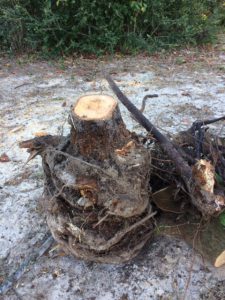
Ten years after installation, this plant was ultimately killed by girdling, circling roots. Photo by Warren Tate, Escambia County Master Gardener.
The best practice for woody ornamentals is to cut any roots that are circling the trunk or container. Homeowners may slice downward through the root ball around the entire plant. For shrubs, it is recommended to shave off “the entire outside periphery of the rootball” to eliminate circling roots. These practices allow the root system to grow outward into new soil and greatly reduce the possibility of girdling roots killing your plants years after establishment.
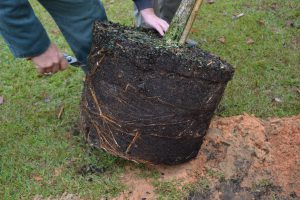
Circling roots are cut before installation. Photo by Beth Bolles, Escambia County Extension.
For more information on shrub establishment, visit the UF Publication Planting Shrubs in the Florida Landscape.
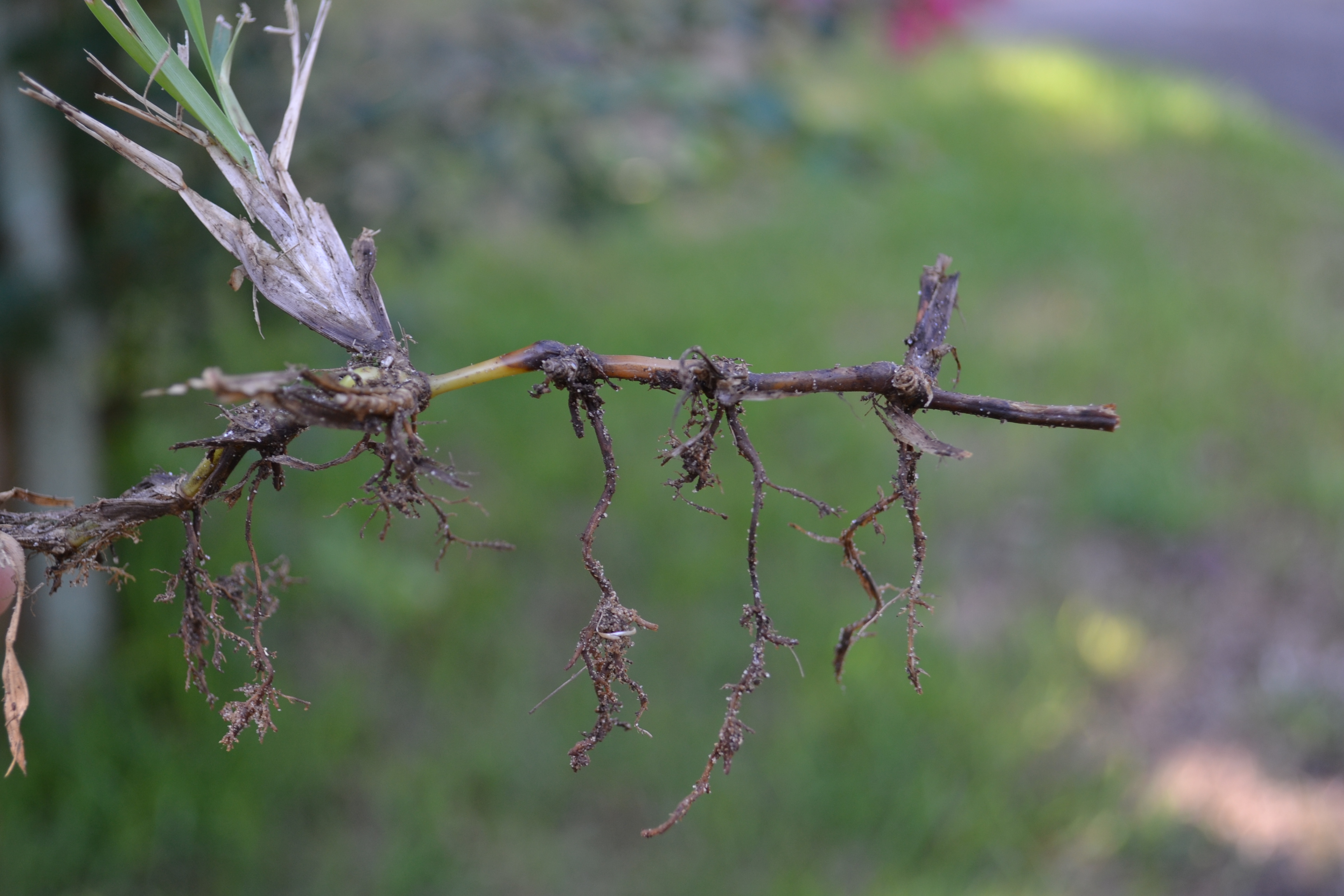
by Beth Bolles | Nov 22, 2016
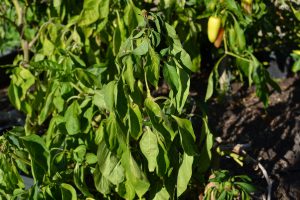
Leaf wilt may indicate more than just dry soil. Photo by Beth Bolles
Plants have specific ways of telling gardeners that there is a problem, but not all plant symptoms lead us directly to the cause. During drier conditions, we often use wilting leaves as an indicator that water is needed. This can be a reliable symptom that the soil is lacking moisture but it is not always the case. Wilting leaves and herbaceous branches actually tell us that there is not adequate water in the plant. It does not necessarily indicate lack of moisture in the soil.
There can be many reasons why water is not being absorbed by roots and moved to tissues in the plant. The obvious place to start is by checking soil moisture. If soil is powdery several inches deep around the plant, water is likely needed. However, if you ball the soil up in your hand and it holds together, there may be another reason for lack of water reaching the upper plant parts. The harder part is determining why the root system is not taking up water. Causes can be a rotted root system from too much water, a poorly developed root ball that has circling or kinked roots, and even problems in the soil such as compaction. Insects, diseases, and other pathogens can also injure root systems preventing the uptake of water.
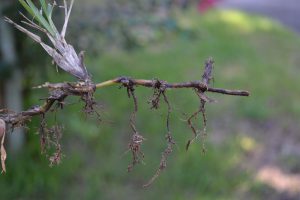
Too much water can cause roots to decay, preventing the uptake of water. Photo by Beth Bolles
So before automatically grabbing the hose or turning on the sprinkler, do a little soil investigation to make sure that the plant wilt is really indicating lack of water in the soil. If you need help in your diagnosis, always contact your local Extension office.
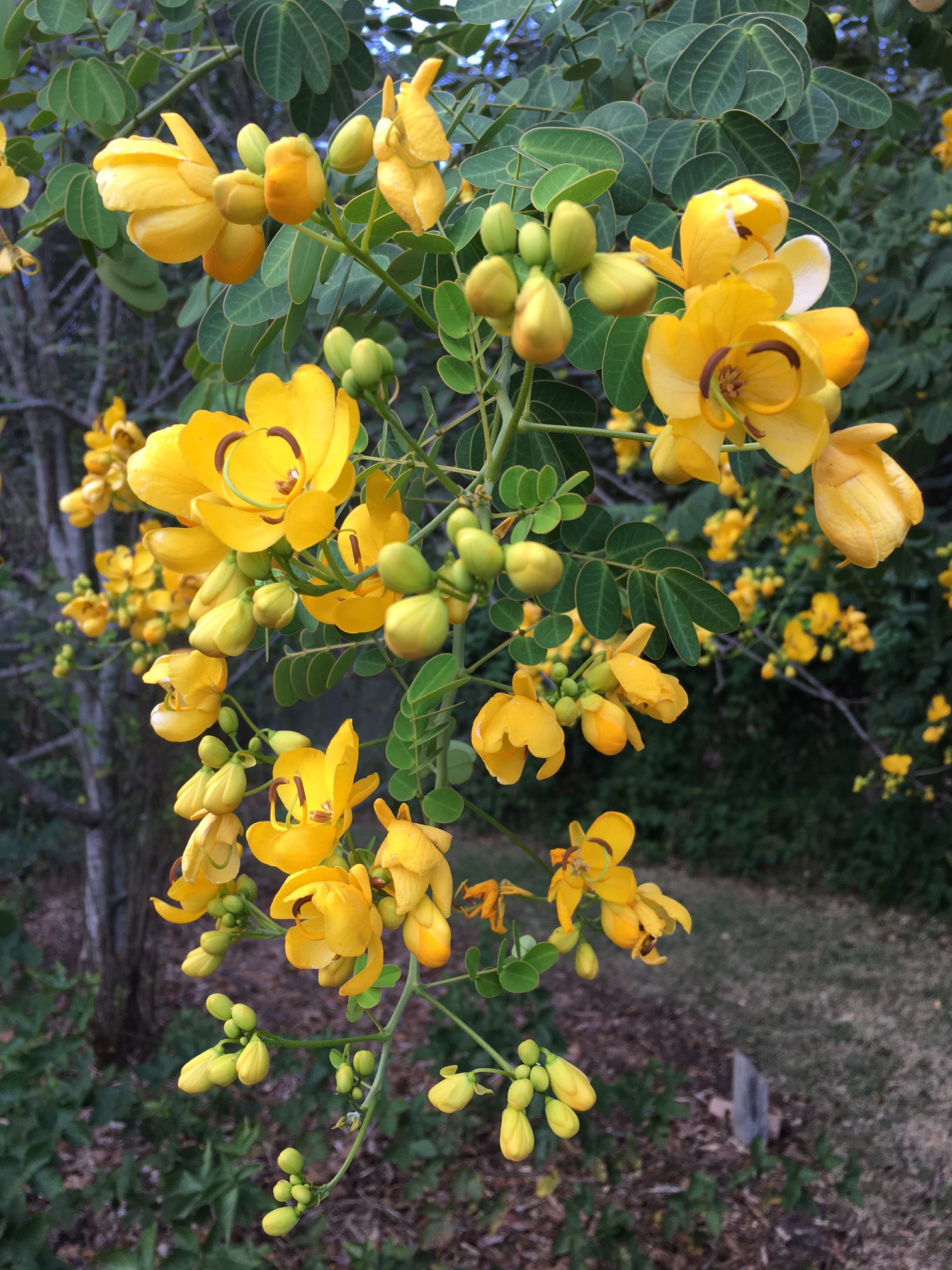
by Mary Salinas | Nov 7, 2016
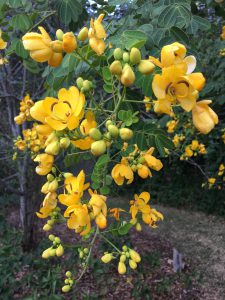
Photo credit: Mary Derrick, UF/IFAS Extension.
When many of our summer blooming plants start fading, yellow cassia, Senna bicapsularis, becomes a show stopper. Late fall and early winter is when it blooms and dazzles. The bright yellow flowers appear in numerous clusters at the tips of this many branched shrub. This makes for a stunning display in sunny areas of the landscape.
Yellow cassia grows to 8 to 12 feet in height and at least twice that in width. In the panhandle it often freezes back when we have a harsh winter. If that happens, prune it to the ground and it will come back the following spring and regain its previous size and beauty by late fall when it is ready to bloom. An advantage is that it is moderately drought and salt tolerant.
The flowers are attractive to bees for pollen although they are not attractive to butterflies as the flowers don’t produce much, if any, nectar. Yellow cassia serves as a host plant for some lovely butterflies. The cloudless sulphur, orange-barred sulphur and the sleepy orange all use cassia to rear their caterpillars. The shrub will rarely be heavily affected by a little herbivory from their caterpillars and will recover to bring you a stunning display the following year.
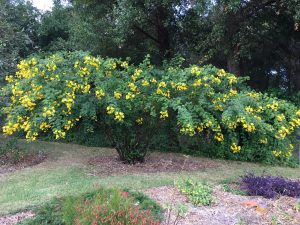
Photo credit: Mary Derrick, UF/IFAS Extension.
If you purchase a yellow cassia, check out the botanical name. Senna bicapsularis is what you want and not Senna pendula var. glabra which is a listed invasive plant species for central and south Florida.
For more information on Florida gardening:
UF/IFAS Gardening Solutions















